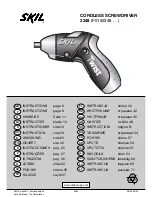
8 ENGLISH
Adjusting the fastening torque
►
Fig.6:
1.
Adjusting ring
2.
Graduation
3.
Arrow
The fastening torque can be adjusted in 17 levels by
turning the adjusting ring. Align the graduations with the
arrow on the tool body. You can get the minimum fas
-
tening torque at 1 and maximum torque at
marking.
The clutch will slip at various torque levels when set
at the number 1 to 16. The clutch does not work at
the
marking.
Before actual operation, drive a trial screw into your
material or a piece of duplicate material to deter-
mine which torque level is required for a particular
application.
ASSEMBLY
CAUTION:
Always be sure that the tool is
switched off and the battery cartridge is removed
before carrying out any work on the tool.
Installing or removing driver bit/
drill bit
►
Fig.7:
1.
Sleeve
Turn the sleeve counterclockwise to open the chuck
jaws. Place the driver bit/drill bit in the chuck as far
as it will go. Turn the sleeve clockwise to tighten the
chuck. To remove the driver bit/drill bit, turn the sleeve
counterclockwise.
Installing hook
Optional accessory
WARNING:
Use the hanging/mounting parts
for their intended purposes only, e.g., hanging the
tool on a tool belt between jobs or work intervals.
WARNING:
Be careful not to overload the
hook as too much force or irregular overburden
may cause damages to the tool resulting in per-
sonal injury.
CAUTION:
When installing the hook, always
secure it with the screw firmly.
If not, the hook
may come off from the tool and result in the personal
injury.
CAUTION:
Make sure to hang the tool
securely before releasing your hold.
Insufficient
or unbalanced hooking may cause falling off and you
may be injured.
►
Fig.8:
1.
Groove
2.
Hook
3.
Screw
The hook is convenient for temporarily hanging the tool.
This can be installed on either side of the tool. To install
the hook, insert it into a groove in the tool housing on
either side and then secure it with a screw. To remove,
loosen the screw and then take it out.
Using hole
WARNING:
Never use the hanging hole for
unintended purpose, for instance, tethering the
tool at high location.
Bearing stress in a heavily
loaded hole may cause damages to the hole, result
-
ing in injuries to you or people around or below you.
►
Fig.9:
1.
Hanging hole
Use the hanging hole at the bottom rear of the tool to
hang the tool on a wall using a hanging cord or similar
strings.
OPERATION
CAUTION:
Always insert the battery cartridge
all the way until it locks in place.
If you can see the
red indicator on the upper side of the button, it is not
locked completely. Insert it fully until the red indicator
cannot be seen. If not, it may accidentally fall out of
the tool, causing injury to you or someone around
you.
CAUTION:
When the speed comes down
extremely, reduce the load or stop the tool to
avoid the tool damage.
Hold the tool firmly with one hand on the grip and the
other hand on the bottom of the battery cartridge to
control the twisting action.
►
Fig.10
Screwdriving operation
CAUTION:
Adjust the adjusting ring to the
proper torque level for your work.
CAUTION:
Make sure that the driver bit is
inserted straight in the screw head, or the screw
and/or driver bit may be damaged.
Place the point of the driver bit in the screw head and
apply pressure to the tool. Start the tool slowly and then
increase the speed gradually. Release the switch trigger
as soon as the clutch cuts in.
NOTE:
When driving wood screw, pre-drill a pilot hole
2/3 the diameter of the screw. It makes driving easier
and prevents splitting of the workpiece.
Drilling operation
First, turn the adjusting ring so that the arrow points to
the
marking. Then proceed as follows.
Drilling in wood
When drilling in wood, the best results are obtained
with wood drills equipped with a guide screw. The guide
screw makes drilling easier by pulling the drill bit into
the workpiece.
Содержание DDF343
Страница 2: ...2 1 2 3 Fig 1 1 2 Fig 2 1 Fig 3 A 1 B Fig 4 1 Fig 5 1 2 3 Fig 6 1 Fig 7 3 1 2 Fig 8 ...
Страница 3: ...3 1 Fig 9 Fig 10 ...
Страница 70: ...70 ...
Страница 71: ...71 ...









































